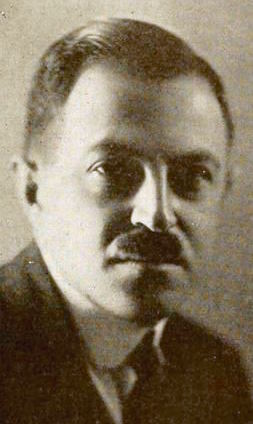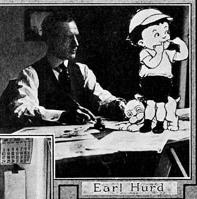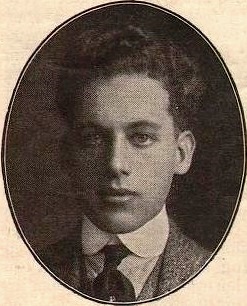
Animation is a filmmaking technique by which still images are manipulated to create moving images. In traditional animation, images are drawn or painted by hand on transparent celluloid sheets (cels) to be photographed and exhibited on film. Animation has been recognized as an artistic medium, specifically within the entertainment industry. Many animations are computer animations made with computer-generated imagery (CGI). Stop motion animation, in particular claymation, has continued to exist alongside these other forms.
The golden age of American animation was a period in the history of U.S. animation that began with the popularization of sound cartoons in 1928 and gradually ended from 1957 to 1969, where theatrical animated shorts began losing popularity to the newer medium of television animation since in 1957, produced on cheaper budgets and in a more limited animation style by companies such as Terrytoons, UPA, Paramount Cartoon Studios, Jay Ward Productions, Hanna-Barbera, DePatie-Freleng, Rankin/Bass and Filmation. In artefact, the history of animation became very important in the United States.

Fleischer Studios was an American animation studio founded in 1929 by brothers Max and Dave Fleischer, who ran the pioneering company from its inception until its acquisition by Paramount Pictures, the parent company and the distributor of its films. In its prime, Fleischer Studios was a premier producer of animated cartoons for theaters, with Walt Disney Productions being its chief competitor in the 1930s.

Max Fleischer was a Polish-American animator, inventor, film director and producer, and studio founder and owner. Born in Kraków, Poland, Fleischer immigrated to the United States where he became a pioneer in the development of the animated cartoon and served as the head of Fleischer Studios, which he co-founded with his younger brother Dave. He brought such comic characters as Koko the Clown, Betty Boop, Popeye, and Superman to the movie screen, and was responsible for several technological innovations, including the rotoscope, the "follow the bouncing ball" technique pioneered in the Ko-Ko Song Car-Tunes films, and the "stereoptical process". Film director Richard Fleischer was his son.

Talkartoons is a series of 42 animated cartoons produced by Fleischer Studios and distributed by Paramount Pictures between 1929 and 1932.
While the history of animation began much earlier, this article is concerned with the development of the medium after the emergence of celluloid film in 1888, as produced for theatrical screenings, television and (non-interactive) home entertainment.

Spümcø, Inc. was an American animation studio that was active from 1989 to 2005 and based in Los Angeles, California. The studio was best known for working on the first two seasons of The Ren & Stimpy Show for Nickelodeon and for various commercials. The studio won several awards, including an Annie Award for Best Animated Short Subject for the music video of the song "I Miss You" by Björk.
Animated films in the United States date back to at least 1906 when Vitagraph released Humorous Phases of Funny Faces. Although early animations were rudimentary, they rapidly became more sophisticated with such classics as Gertie the Dinosaur in 1914, Felix the Cat, and Koko the Clown.

Traditional animation is an animation technique in which each frame is drawn by hand. The technique was the dominant form of animation in cinema until the end of the 20th century, when there was a shift to computer animation in the industry, specifically 3D computer animation.

Bray Productions was a pioneering American animation studio that produced several popular cartoons during the years of World War I and the early interwar era, becoming a springboard for several key animators of the 20th century, including the Fleischer brothers, Walter Lantz, Paul Terry, Shamus Culhane and Grim Natwick among others.

Out of the Inkwell is an American animated film series of the silent era. It was produced by Max Fleischer from 1918 to 1929 and was called The Inkwell Imps at the end of that period.
A cel, short for celluloid, is a transparent sheet on which objects are drawn or painted for traditional, hand-drawn animation. Actual celluloid was used during the first half of the 20th century, but since it was flammable and dimensionally unstable it was largely replaced by cellulose acetate. With the advent of computer-assisted animation production, the use of cels has been all but abandoned in major productions. Disney studios stopped using cels in 1990 when Computer Animation Production System (CAPS) replaced this element in their animation process, and in the next decade and a half, the other major animation studios phased cels out as well.
Color Classics are a series of animated short films produced by Fleischer Studios for Paramount Pictures from 1934 to 1941 as a competitor to Walt Disney's Silly Symphonies. As the name implies, all of the shorts were made in color format, with the first entry of the series, Poor Cinderella (1934), being the first color cartoon produced by the Fleischer studio. There were 36 shorts produced in this series.

Farmer Al Falfa, is an animated cartoon character created by American cartoonist Paul Terry. He first appeared in Down On the Phoney Farm (1915), a short Terry cartoon distributed by the Thanhouser Company. Next came a series of shorts produced by Terry for Bray Studios, starting with Farmer Al Falfa's Cat-Tastrophe (1916).

An animation studio is a company producing animated media. The broadest such companies conceive of products to produce, own the physical equipment for production, employ operators for that equipment, and hold a major stake in the sales or rentals of the media produced. They also own rights over merchandising and creative rights for characters created/held by the company, much like authors holding copyrights. In some early cases, they also held patent rights over methods of animation used in certain studios that were used for boosting productivity. Overall, they are business concerns and can function as such in legal terms.
Puppetoons is a series of animated puppet films made in Europe (1930s) and in the United States (1940s) by George Pal. They were made using replacement animation: using a series of different hand-carved wooden puppets for each frame in which the puppet moves or changes expression, rather than moving a single puppet, as is the case with most stop motion puppet animation. They were particuarly made from 1932-1948, in both Europe and the US.

Paul Houlton Terry was an American cartoonist, screenwriter, film director and producer. He produced over 1,300 cartoons between 1915 and 1955 including the many Terrytoons cartoons. His studio's most famous character is Mighty Mouse, and also created Heckle and Jeckle, Gandy Goose and Dinky Duck.

The Sinking of the Lusitania (1918) is an American silent animated short film by cartoonist Winsor McCay. It is a work of propaganda re-creating the never-photographed 1915 sinking of the British liner RMS Lusitania. At twelve minutes it has been called the longest work of animation at the time of its release. The film is the earliest surviving animated documentary and serious, dramatic work of animation. The National Film Registry selected it for preservation in 2017.

Earl Hurd was a pioneering American animator and film director. He is noted for creating and producing the silent Bobby Bumps animated short subject series for early animation producer J.R. Bray's Bray Productions. Hurd and Bray are jointly responsible for developing the processes involved in cel animation, and were granted patents for their processes in 1914.

Wallace A. Carlson was a pioneering American animator and comic strip artist based in Chicago. Known to his friends as Wally Carlson, he usually signed his work as Wallace Carlson.













